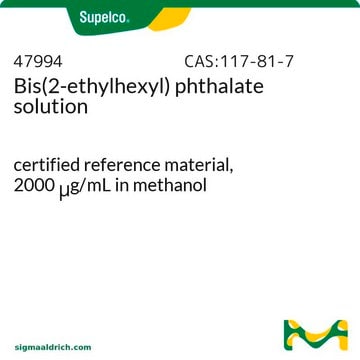Products may be shipped at a different temperature than the recommended long-term storage temperature. If the product quality is sensitive to short-term exposure to conditions other than the recommended long-term storage, it will be shipped on wet or dry-ice. If the product quality is NOT affected by short-term exposure to conditions other than the recommended long-term storage, it will be shipped at ambient temperature. As shipping routes are configured for minimum transit times, shipping at ambient temperature helps control shipping costs for our customers. For more information, please refer to the Storage and Transport Conditions document: https://www.sigmaaldrich.com/deepweb/assets/sigmaaldrich/marketing/global/documents/316/622/storage-transport-conditions-mk.pdf
36735
Bis(2-ethylhexyl) phthalate
PESTANAL®, analytical standard
Sinonimo/i:
DEHP, Phthalic acid bis(2-ethylhexyl ester), ‘Dioctyl’ phthalate
Scegli un formato
About This Item
Prodotti consigliati
Grado
analytical standard
Livello qualitativo
Nome Commerciale
PESTANAL®
Durata
limited shelf life, expiry date on the label
tecniche
HPLC: suitable
gas chromatography (GC): suitable
P. ebollizione
386 °C (lit.)
Densità
0.985 g/mL at 20 °C (lit.)
applicazioni
agriculture
cleaning products
cosmetics
environmental
food and beverages
personal care
Formato
neat
Stringa SMILE
CCCCC(CC)COC(=O)c1ccccc1C(=O)OCC(CC)CCCC
InChI
1S/C24H38O4/c1-5-9-13-19(7-3)17-27-23(25)21-15-11-12-16-22(21)24(26)28-18-20(8-4)14-10-6-2/h11-12,15-16,19-20H,5-10,13-14,17-18H2,1-4H3
BJQHLKABXJIVAM-UHFFFAOYSA-N
Cerchi prodotti simili? Visita Guida al confronto tra prodotti
Descrizione generale
Applicazioni
Note legali
Avvertenze
Danger
Indicazioni di pericolo
Consigli di prudenza
Classi di pericolo
Repr. 1B
Codice della classe di stoccaggio
6.1C - Combustible acute toxic Cat.3 / toxic compounds or compounds which causing chronic effects
Classe di pericolosità dell'acqua (WGK)
WGK 1
Punto d’infiammabilità (°F)
392.0 °F - Pensky-Martens closed cup
Punto d’infiammabilità (°C)
200 °C - Pensky-Martens closed cup
Dispositivi di protezione individuale
Eyeshields, Gloves, type ABEK (EN14387) respirator filter
Scegli una delle versioni più recenti:
Possiedi già questo prodotto?
I documenti relativi ai prodotti acquistati recentemente sono disponibili nell’Archivio dei documenti.
I clienti hanno visto anche
-
How is shipping temperature determined? And how is it related to the product storage temperature?
1 answer-
Helpful?
-
-
How can I determine the shelf life / expiration / retest date of this product?
1 answer-
If this product has an expiration or retest date, it will be shown on the Certificate of Analysis (COA, CofA). If there is no retest or expiration date listed on the product's COA, we do not have suitable stability data to determine a shelf life. For these products, the only date on the COA will be the release date; a retest, expiration, or use-by-date will not be displayed.
For all products, we recommend handling per defined conditions as printed in our product literature and website product descriptions. We recommend that products should be routinely inspected by customers to ensure they perform as expected.
For products without retest or expiration dates, our standard warranty of 1 year from the date of shipment is applicable.
For more information, please refer to the Product Dating Information document: https://www.sigmaaldrich.com/deepweb/assets/sigmaaldrich/marketing/global/documents/449/386/product-dating-information-mk.pdfHelpful?
-
-
Hello I would like to know the density of this product (pestanal Bis(2-ethylhexyl) phthalate; CAS Number: 117-81-7). I searched but couldn't find it. I would be very grateful if you could help me. Thank you from now.
1 answer-
The density of this item is 0.985 g/mL at 20 °C (lit.)
Helpful?
-
-
Good morning! What is the solubilty of the substance DEHP, please? And the solubility of the benzyl butyl phthalate? Thank you!
1 answer-
Both compounds are only slightly soluble in water. Product 36735 is not tested for solubility. According to the literature, it is soluble in ethanol, DMSO, benzene, and ether. No rate is reported. Also, according to the literature, the solubility of benzyl butyl phthalate (CAS 85-68-7,) is in chloroform, DMSO, and methanol. No rate is reported.
Helpful?
-
Active Filters
Il team dei nostri ricercatori vanta grande esperienza in tutte le aree della ricerca quali Life Science, scienza dei materiali, sintesi chimica, cromatografia, discipline analitiche, ecc..
Contatta l'Assistenza Tecnica.









